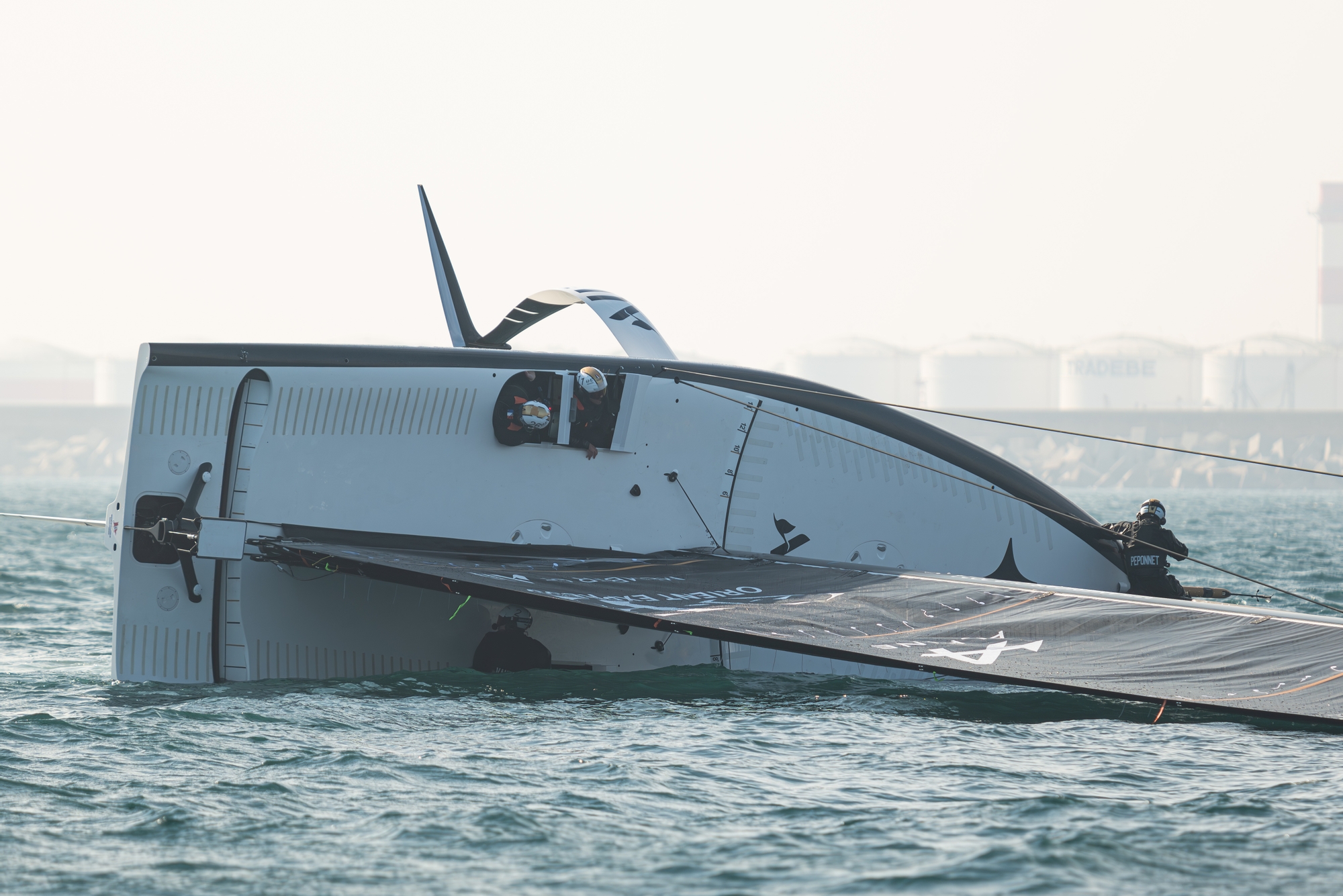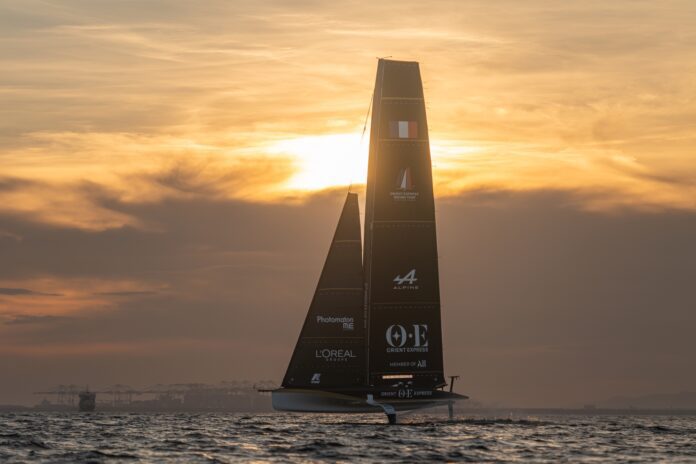In Barcelona, the Orient Express Racing Team embarked on an afternoon dock-out that extended into a long session on the water, lasting until sunset. The French team is diligently familiarizing themselves with the new systems onboard their AC40, which has now been transitioned squarely into LEQ12 development mode. They have also introduced an intriguing inventory of new sails into their wardrobe. Despite an initial low-speed capsize, which appeared to be caused by an electronic shut-down rather than a sailing-related issue, the team had another highly productive day, making significant strides in their preparations.

Once up and flying, and after some technical shore-team intervention, it was very much back to business as the superb conditions of Barcelona these past two weeks continued with a south westerly bringing consistent breeze of 12-14 knots. As the sea-state increased mid-afternoon, as is so often the case down here, Quentin Delapierre and Kevin Peponnet dialled the LEQ12 lower to the water and we saw some really sharp sail control from Matthieu Vandame and Jason Saunders. The sailors put in a big shift, sailing through to sunset once again and looked magnificent on the water with the city skyline as a backdrop.

With this relatively new team getting to grips with all the new systems, coach Thierry Douillard will have been pleased with the foil-to-foil percentages executed today at 69% over 48 tacks and gybes but even more pleasing will have been the moding that the team were able to perform. Wide cant angles and windward heel upwind were the norm whilst downwind there were some exercises with high ride-height that looked interesting and on the limit. Time in the boat and time on the water are the two elements that you just can’t buy in the America’s Cup, but the French look increasingly assured and there’s a growing confidence, certainly in the sailing team that they are making steps forward and getting more comfortable with the boat.

This sentiment was echoed by Bruno Dubois, one of the chief architects of the Orient Express Racing Team and Chief Executive Officer of the campaign, when he spoke to the recon team on the dock after sailing: “I think we’re spot on for what we were looking for. We took the boat over in in August last year, we did directly Villanova, we had another three- or four-weeks training before sending the boat to Jeddah and the boat came back at the beginning of January, so we didn’t have a lot of time training. Our plan was beginning of January to start on LEQ12 mode with different systems, a bit more what we going to have on the AC75 – sails and systems – and we’re really surprised how well the guys and the girls are doing too, playing with the boats probably because they have been sailing in other series with manual flight control also so that helped…so I’m quite pleased…on the sailing point of view I think we’re a little bit advanced on what I thought we would be so we have another couple of months more sailing that way too. I really want the crew to have indigestion of LEQ12 so they will be sick and tired to be on that boat and will be very happy to join a jump on the AC75, so I think yeah, we’re on track at this point.”

Talking America’s Cup strategy, it was assumed that the French would build early and get their AC75 on the water ahead of everyone else. However, Bruno gave a great insight into the team’s tactics saying: “It’s coming soon so don’t worry about that, we will not launch a boat in August! Really looking forward for it…We had some choices to make at one point and it was about having a very ‘performance’ boat late or something different with less performance but earlier. So, it’s a balance between those two that we had to make, and we decided to go for a later launching. Exciting, let’s see what they’re coming with.”

The team, and indeed the America’s Cup world, are excited to see the French boat but Bruno highlighted the challenges they face, saying: “For us the main challenges is that we are alone with one training boat and an AC75…we bought a design package from Emirates Team New Zealand, so we are not going to redevelop what we think from those people who are the best last time, we’re going to just go with what they are giving us and it’s fine, and our challenge will be to understand what they’re giving us because when we launch the boat, that’s it, we are all by ourself and we cannot exchange anymore, there’s no communication allowed. So, the challenge for us is to understand exactly the product we’re going to get. We’re doing match-racing on the simulator so that’s fine for us, it would be nice to do it on the water like some of them are doing with the AC40s, but you know that’s the story of our campaign, we don’t have that opportunity and we have to play with that and use that as an opportunity to do something else. For me that’s fine.”

More sailing today (Thursday) for the French ahead of some tricky conditions coming in across Barcelona for the weekend. Every day is a school day now and vital for the team’s progress. (Magnus Wheatley)
On-Water Recon Report – Orient Express Racing Team: The OE AC-40 team began the day by lifting the mast onto the boat and conducting various tests, including remote-controlled arm movements. Sailors received instructions on new settings, and the sails were raised and lowered for preparation. After some induction, the crew faced challenges with the tack part of the sail but managed to resolve the issue. The AC-40 experienced a capsize incident, requiring assistance and repairs. Despite the setbacks, they later sailed successfully, conducting manoeuvres in both upwind and downwind directions. Some battery and jib replacements were made, and the team practiced tacking, gybing, lay lines, bearing away and luffing manoeuvres. The day concluded with the team returning to the harbour around 18:30. Jose L. Piñana – AC Recon

12:57: Dock Out. The head of the main was already in position to hoist the sail up.
13:15: It looked like the crew were having some problems related to the tack part of the sail.
13:39: Problem solved, and the Chase Boat towed the AC-40 out of the harbour.
13:45: The AC-40 started self-sailing just after getting out from the harbour but two minutes later decided to stop and kept sailing without foiling.
13:48: The AC-40 went to tack without foiling and in that moment, something went wrong as it looked like the boat systems froze, the arms were not moving and could not compensate the righting moment of the sail, so it started to heel until it capsized.
13.51: Chase Boat towed the capsized AC-40 against the wind helping it to get back to a straight position. Then after the chase boat got beside the AC-40 and three technicians jumped to make a check of all systems.
An electronic and hydraulic technician that were onshore had to assist the AC-40. There was some damage that luckily could be fixed. As a consequence, the team could not sail completely in manual mode and switched to auto-pilot.
Meanwhile we checked the wind conditions: the day on the water was beautiful with a small chop and a nice breeze of 11 to 13-14 knots from the SW.
15:17: Finally, the OE AC-40 starts sailing and it does it in a starboard tack up wind in an estimated 57º TWA, 30 knots speed and later bears-away into a downwind and keeps sailing in a 154º TWA, 33 knots speed. After some time sailing downwind, they make a gybe that goes into a touchdown.
15:44: Onto the foils and sailing in port tack they changed the course for 2-3 times from upwind to downwind. Then after they started downwind sailing at 160º TWA, 33 knots. After some time, they gybe very nicely and continue going down wind in starboard tack. Then suddenly they decided to luff and started pointing 60º TWA upwind at a speed of 30-31 kn. After three good tacks they decided to stop.
16:07: Started sailing again in downwind and starboard tack, then after they gybe and keep on sailing in portside, they quickly gybe again and then they went for a long run sailing on starboard 160º TWA, finally they gybe again and continue sailing downwind in port side. Then after two successful gybes more they perform a luff and start sailing upwind on port tack. They make a touch down tack and stopped.
16:37: Upwind and performed 8 really good tacks in a row. After the last tack they sailed until one of the yellow marks that are in front the Barcelona harbour and then after they bore-away and start sailing downwind.
16:40: Stopped for replacement of batteries and replaced Jib LEQ12-J3 for OD-J2.
17:08: Started sailing again but quickly stopped as the jib got its tension released. The Chase Boat helped to put the tension back on the jib and started sailing again.
17.20: After a short starboard reach, the Chase Boat stopped, and they proceed with some upwinds and downwinds using a yellow iron mark as a top mark. After some laps the Chase Boat went more downwind, and the AC-40 used it as a bottom mark. With these references they did three laps with the following manoeuvres:
- First lap: two tacks and two gybes. At this lap the last gybe finished in a complete touch down. It looked like the rudder was too close to the surface and the alarm mode get ‘On’ and in consequence put the flaps full up to put the rudder immediately in a deeper spot what means to get the bow higher up.
- Second lap: four tacks and three gybes (one each with touch down, the other ones great).
- Third lap: one tack and three gybes.
17:50: OE team sailed back to harbour and at 18:30 h they make the dock in (three tacks were done on the way back).






